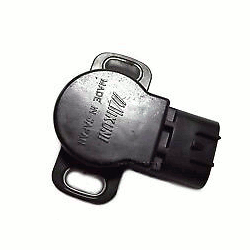In combustion engines, ignition timing refers to the moment when the spark is ignited relative to the current position of piston in cylinder (the crankshaft angle).
The need for igniting a spark before (time advancing) or later (time retarding) of piston coming to the top dead center (when there's maximal compression in cylinder) is that mixture of vaporized fuel and air does not burn instantly. Some time is required for mixture to expand and burn, and piston moving (crankshaft rotation) can shorten or extend the time frame in which the mixture burning can occur.
 |
| 4-stroke V2 engine (DOHC) |
The point in time when the spark is ignited is expressed as the angle in crankshaft rotation BEFORE the piston in cylinder reaches the top dead center (before top dead center, BTDC). The spark is ignited before TDC in order to provide enough time for expanding of gases and maximal burning to occur exactly in moment when the piston is in TDC when the maximal thrust is achieved. Initiating of spark after TDC (after top dead center, ATDC) is not wanted and causes engine backfiring.
To determine the moment when a spark should be ignited is of crucial importance for optimal engine operation. The spark ignited too early or too late in combustion cycle is often the cause of excessive vibration and engine damage. Upon the moment when the spark is ignited depends consumption efficiency, longevity and power of engine.
There are many factors affecting what is the best moment when a spark in cylinder should be ignited. Some of them are the speed and load of engine, type and condition of spark plugs, content and dirt in fuel, fuel temperature and pressure, temperature of air and engine itself, vacuum in cylinders, etc.
The time needed for mixture to burn in cylinder is more or less constant. Contrary to that, the time of one stroke (cycle) depends on engine current speed (rpms). As higher rpms are, as shorten the period of one stroke is. In order to target the burning maximum at TDC, the spark initiation has to be advanced in time. For smaller and simpler 2-stroke engines the time advance (angle) of spark ignition is fixed but for bigger engines it is variable and it is controlled by special device.
Older motorcycles for ignition timing use mechanical distributor which is based on inertia (it has rotational weight or springs) and is controlled by vacuum from intake branch. Modern motorcycles use computerized systems which control the moment of ignition dependent of engine speed and its load. For automatic management of ignition timing Yamaha Virago motorcycles use Transistor Controlled Ignitor (TCI).
Ignition timing of Viragos
In specifications the moment when spark is ignited is expressed as an angle before TDC for engine in idle mode (1200 rpms for Viragos). For xv535(S) Virago it is 8°.
 |
| Yamaha xv535 Virago - ignition timing 8°@1200 rpms up to 29°@4000 rpms |
So the factory settings for Virago xv250 and xv535 are that initial ignition timing is 8° (at 1200 rpms) moving to 27° and 33° before TDC as rotation increases, and for Virago xv750 and xv1100 that is 10° (at 1200 rpms) and moves up to 35° and 48° respectively.
Pressure sensor
 |
| Pressure Sensor Mitsubishi prod code J9T019 1TA-82380-20-00 |
Virago models xv1000 and xv1100 are equipped with so called pressure sensor (booster sensor) which sends the data about current vacuum to TCI and then it takes it into account for calculating ignition timing.
code 1TA-82380-20-00 from 1986. until 1999.
The diagram bellow shows the change of ignition timing in correlation to rpms, but also its drift (depicted as change from yellow to red area) as a result of different vacuums given by pressure sensor.
 | |
| Mikuni's Throttle Position Sensor, TPS 3P6-85884-00-00 |
Throttle Position Sensor, TPS
Later versions of xv1100 Viragos for Japanese and UK markets from 1996 onward are equipped with newer sensor which is called Throttle Position Sensor, TPS. This is actually a measuring extension to Mikuni's carburetor BTS40 measuring the throttle position. It has been produced by Japanese company Mikuni, the maker of carburetor.code 3P6-85884-00-00 from 1996. (JPN/UK market)
This sensor was later implemented in newer Yamaha XVS models (DragStar).
 |
| The drift of ignition time depending on vacuum given by pressure sensor |
 |
| TPS on Yamaha xv1100 Virago - mounted on left carburetor (rear cylinder) |




Nema komentara:
Objavi komentar